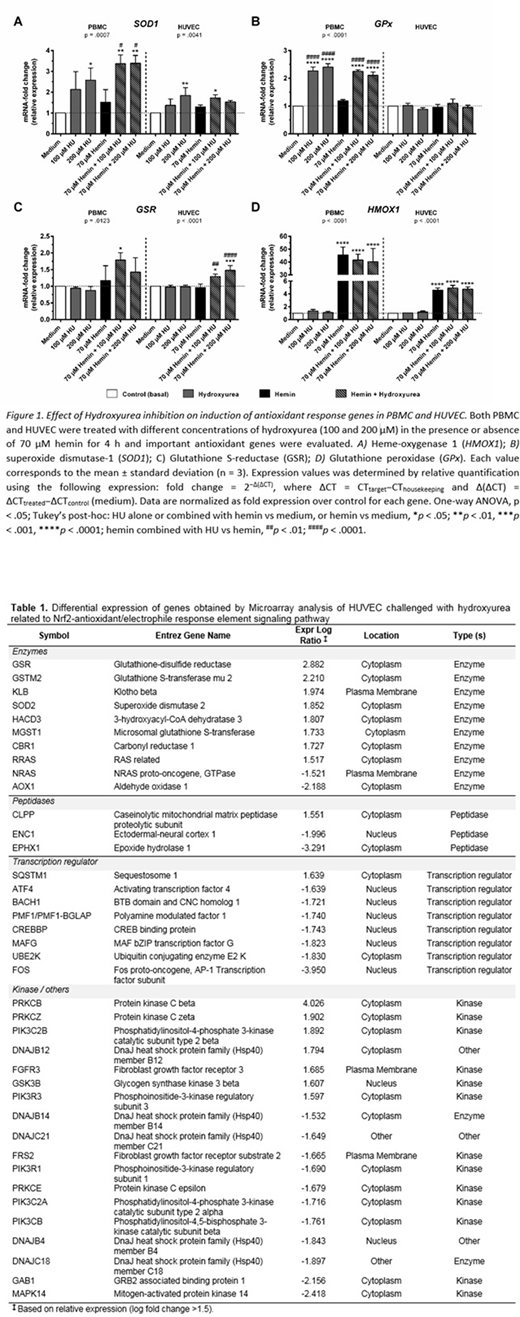Abstract
Introduction: The pathophysiology of sickle cell anemia (HF) is characterized by hemolytic and intermittent vasoconstrictive events with increased redox status in the vascular microenvironment that favors the chronic inflammation. Objectives: To investigate whether hydroxyurea (HU) acts in the inhibition/minimization of reactive oxygen/nitrogen species (ROS/RNS) and in the modulation of in vitro the antioxidant genes expression.
Methods: DPPH (1,1-diphenyl-2-picrylhydrazyl) radical scavenging assay was performed to determine the antioxidant activity of HU using L-ascorbate (L-Asc) and butylated hydroxytoluene (BHT) as antioxidant controls. Human umbilical vein endothelial cell (HUVEC) and peripheral blood mononuclear cells (PBMC) were challenged with HU in the presence or absence of hemin for evaluation the cytotoxicity, inhibition of superoxide anions, nitrate/nitrite production and expression of antioxidant enzymes SOD1 (superoxide dismutase-1); GPx (glutathione peroxidase); GSR (glutathione-disulfide reductase); and HMOX1 (heme oxygenase-1 by RT-qPCR. Microarray analyses were performed on HUVEC stimulated with HU.
Results: HU showed scavenging activity (similar to BHT) at concentrations equivalent to that found in the plasma of patients taking the drug (~200 μM). Treatments with HU alone or in combination with hemin did not induce toxicity in PBMC and HUVEC. HU decreases the accumulation of superoxide anions in PBMC in the presence or absence of hemin and the combined treatment of HU with hemin stimulated nitrate/nitrite production in PBMC. HU increases expression of SOD1 and GPx in PBMC and HUVEC. The increase in GSR expression was observed in PBMC and HUVEC submitted to the combined treatment of HU with hemin. HU did not induce HMOX1 expression and did not decrease its expression in combination with hemin in both, PBMC and HUVEC (Figure 1). The microarray assay showed that HU induces the expression of cellular antioxidant components, such as SOD2, GSR, GST1 (glutathione S-transferase-1, GSTM2 (glutathione S-transferase mu 2), MGST1 (microsomal glutathione S-transferase 1), CBR1 (carbonyl reductase 1), protein kinases phosphatidylinositol 3-phosphate C (PRKCB, PRKCZ, PIK3C2B) and p62/SQSTM1 (sequestosome 1) (Table 1). In contrast, a decrease in BACH1 (BTB domain and CNC homolog 1) transcriptional factor expression was observed. Upstream analysis demonstrated prediction of activation for the transcriptional factor JUN and miR-155-5p.
Conclusion: The findings indicate that HU can act (i) directly inhibiting on the direct inhibition of ROS/RNS; (ii) inducing nitrite/nitrate production in the presence of hemin; (iii) besides stimulating the antioxidant cellular response by inducing the antioxidant/electrophile response element (ARE/EpRE) mediated by Nrf2 under p62/SQSTM1 regulation.
No relevant conflicts of interest to declare.
Author notes
Asterisk with author names denotes non-ASH members.


This feature is available to Subscribers Only
Sign In or Create an Account Close Modal